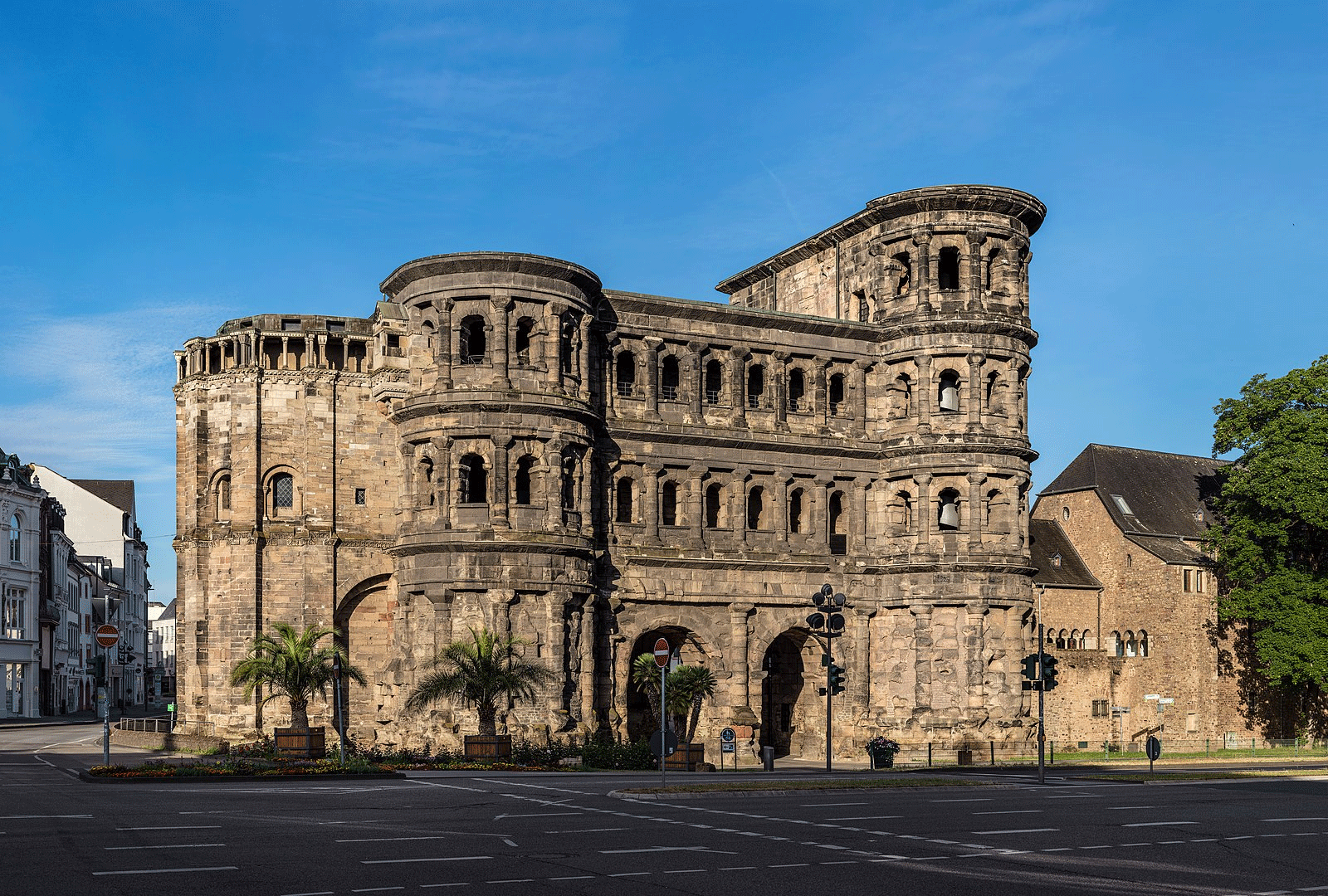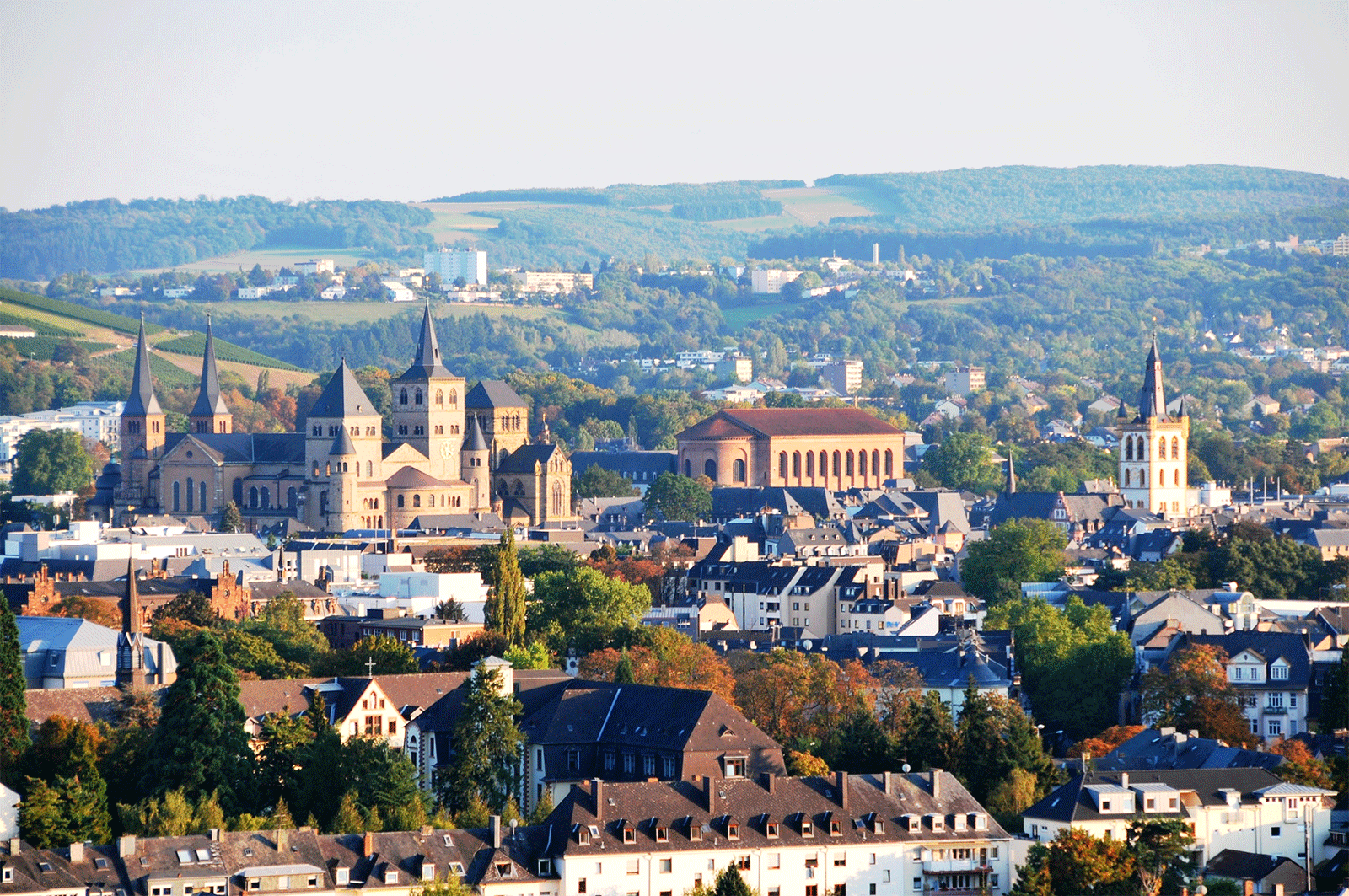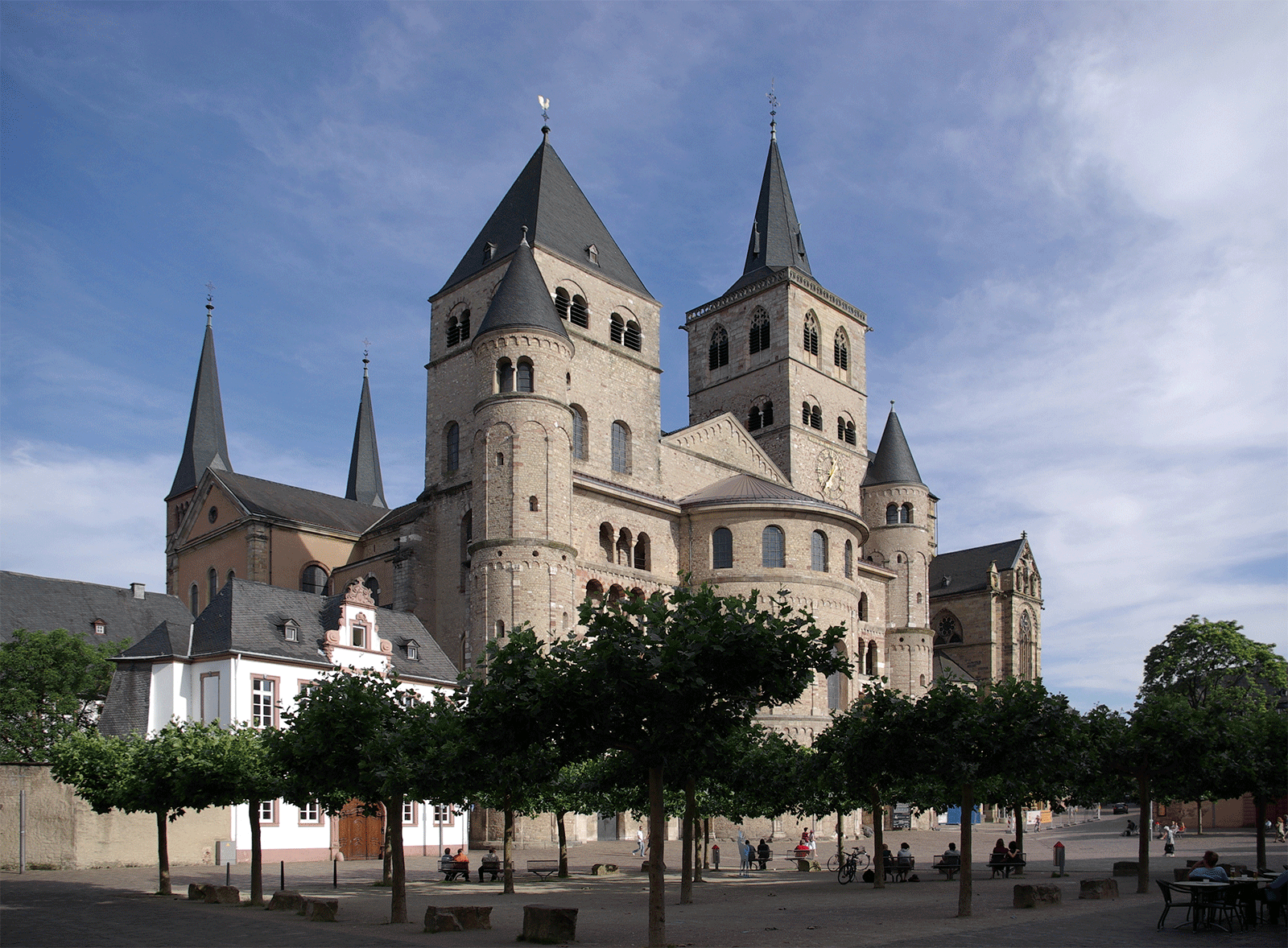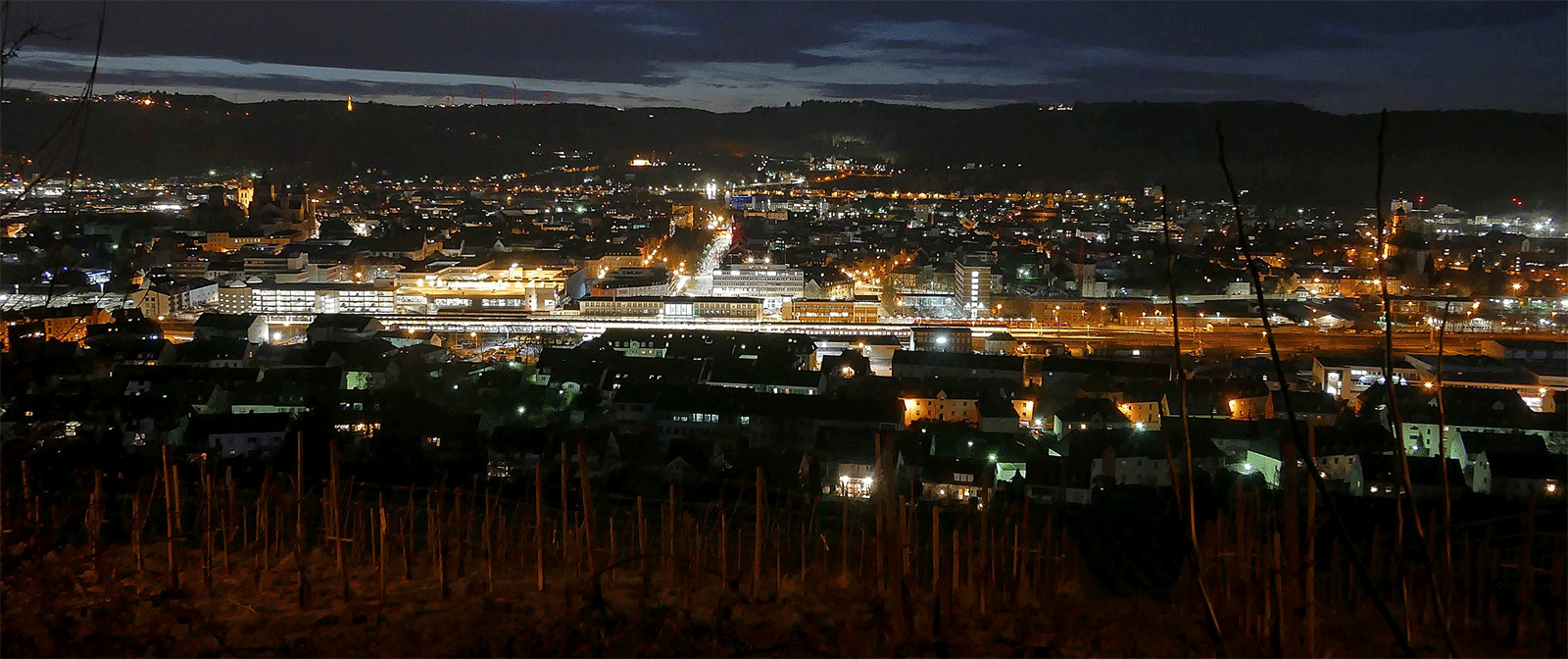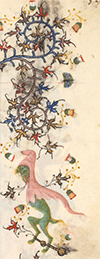
TREVES,(German. Trier).
A city of Prussia, in
the Rhine Province, on the right bank of the Moselle, 69 miles southwest of
Coblenz. It is situated in a region of hills, vineyards, and woods, and
presents a picturesque appearance. The town lies in a compact form, surrounded
on three sides by promenades called allées. In the old city proper the streets
are narrow and crooked. On the north is the Porta Nigra, an ancient fortified
gate with towers — a splendid Roman relic. In the northeastern part of the city
stands the cathedral, one of the oldest churches in Europe. The ancient edifice
on whose site it stands appears to have been used as a church already in Roman
times. The building has been repeatedly restored as the result of wars and the
ravages of centuries. Among its contents are an alleged nail from the cross,
and the famous seamless ‘Holy Coat,’ which is exposed to view at stated, though
not frequent, times. There are fine cloisters leading to the charming Liebfrauenkirche — an early Gothic structure
belonging to the first half of the thirteenth century.
In the southeastern
part of Treves is the spacious Palace Square, at the north end of which stands
a brick basilica dating probably from the commencement of the fourth century,
now used as a Protestant church. At the south end of the square rises the Roman
palace, a picturesque mass of ruins. The valuable provincial museum is near by.
Among its remarkable antiquities are 60 hermæ, torsos
of Cupid and of an amazon, a mosaic credited to Monnus,
and the Roman tombs from Neumagen, dating from the
commencement of the Christian Era and representing the costumes and daily life
in this region at that period. A short distance southeast of the city is a
Roman amphitheatre, built in Trajan's time. In the
southwestern part of Treves, close to the Moselle, are the Roman baths — a vast
and impressive ruin. Two miles to the west, on a hill, rises the Column of the
Virgin, commemorating the promulgation of the dogma of the Immaculate
Conception.
Treves is usually
considered the most ancient town of Germany. It was the capital of the Celtic
Treviri, from whom it took its name (anciently Augusta Trevirorum).
The Romans made it a colony and it grew in importance. It was an Imperial
residence in the later times of the Roman Empire, which explains the presence
of the magnificent Roman relics.
Trier contains more
important Roman remains than any other place in northern Europe. Perhaps the
oldest remains are some of the piers and buttresses of the bridge over the
Moselle, which may date from about 28 B.C. The well-preserved amphitheatre just outside the modern town to the south-east
was probably built in the reign of Trajan or Hadrian. Its eastern side is built
into the hill, its longer diameter is 76 yds., and it accommodated seven or
eight thousand spectators. In 306 the emperor Constantine the Great caused
multitudes of Frankish prisoners to be thrown to the beasts here, and in 313
made a similar spectacle of the captive Bructeri. The
most remarkable Roman building in Trier is the Porta Nigra, the
north gate of the city, a huge fortified gateway, 115 ft. long, 75 to 93 ft.
high and 29 ft. deep, built of sandstone blocks blackened with age (whence the
name), and held together with iron clamps. The age of this building is very
uncertain; it has been assigned to dates ranging from the 1st to the 4th
century A.D. It is also called the Simeonstor,
after a Greek hermit who inhabited it. On his death in 1035 Archbishop Poppo
converted the gate into two churches, one above the other, but all the
additions except the apse have now been removed. In the south-east corner of
the city are the picturesque ruins of the Roman imperial palace, and near the
bridge are the extensive substructures of the 4thcentury Roman baths, 660 ft.
in length. On the Constantinsplatz stands the
magnificent brick basilica, probably of the age of Constantine, though the
south and east walls are modern. Having been converted into a palace for the
Frankish kings and their deputies, it passed in 1197 to the archbishops, and
was restored (1846–1856) and turned into a Protestant church. The adjoining
barracks were formerly the elector's palace. Another Roman basilica forms the
nucleus of the cathedral. Built under the emperors Valentinian I. and Gratian
as a quadrilateral hall with four huge granite columns (now removed) in the centre, it was converted into a church about the close of the
4th century, and restored by Bishop Nicetius about
550. It is the most important pre-Carolingian church in Germany. Archbishop
Poppo and his successors in the 11th and 12th centuries extended the cathedral
westwards and added an apse at each end. The vaulting of the nave and aisles
and the beautiful cloisters were added in the 13th century. In the vaults are
buried twenty-six archbishops and electors. Among the monuments are those of
the electors Richard von Greiffenklau (d. 1531) and
Johann von Metzenhausen (d. 1540), fine examples of
German Renaissance work. The most famous of the relics preserved in the
cathedral is the “Holy Coat of Trier,” believed by the devout to be the
seamless robe of the Saviour, and said to have been
discovered and presented to the city by the empress Helena. Since 1512 it has
been periodically exhibited. The exhibition of 1844, which was attended by more
than a million pilgrims, aroused protests, resulting in the formation of the
sect of German Catholics (q.v.). In 1891 nearly two million
pilgrims viewed the coat, and eleven miraculous cures were claimed.
The cloisters
connect the cathedral with the church of Our Lady (Liebfrauenkirche),
a beautiful building in the form of a circle intersected by a cross, with a
lofty vault, built 1127–1143, and said to be the oldest Gothic church in
Germany.
The earliest
churches were without the walls. Of these St Matthias in the south, now
represented by a 12th-century building, has a Christian cemetery of the Roman
age.
In the market-place
is the market cross, said to date from 958, and a beautiful Renaissance
fountain, the Petersbrunnen, erected in
1595. Close by are the Steipe or Rotes
Haus, formerly the town hall, of the 15th century, and the Frankenturm or propugnaculum,
of the 10th century, said to be the oldest stone domestic building in Germany.
The Provincial
Museum (1885–1889) contains many Roman and medieval antiquities. The town
library contains about 100,000 volumes, including some valuable examples of
early printing. Among its most treasured MSS. are the codex aureus,
a copy of the gospels presented to the abbey of St Maximin by Ada, a reputed
sister of Charlemagne, and the codex Egberti of
the 10th century.
At Igel near Trier
is a very remarkable Roman column, 83 ft. high, adorned with sculptures. It
dates from the 2nd century, and was the family monument of the Secundini. At Nennig is a fine Roman mosaic pavement.
The industries of
Trier include iron-founding, dyeing and the manufacture of machinery. There is
a school of viticulture and a very considerable trade in Moselle wines,
especially during the annual auctions.
History.—Trier had had two
periods of greatness, firstly as the favourite residence of Constantine the Great and his successors in the west, and secondly
as the capital of a powerful spiritual electorate.
The Treveri or
Treviri, from whom the city derived its name, were one of the most powerful
tribes among the Belgae, and according to Julius Caesar, who conquered them in
56 B.C., possessed the best cavalry in Gaul. Attempts have been made to
show that they were of German origin (see Belgae), but although they were doubtless subject to
Germanic influences, they spoke a Celtic language. Their chiefs, Indutiomarus,
who raised a rebellion against the Romans in 54 B.C., and his successor
Cingetorix have Celtic names, and St Jerome, who had lived in Trier, declares
that their language in his day (c. 370) resembled that of the
Galatians. An insurrection under Julius Florus in A.D. 21 was
soon quelled. The Roman city, Augusta Treverorum, was probably fortified by
Augustus about 14 B.C., and organized as a colony about A.D. 50
in the reign of Claudius, but is not mentioned before the war of Civilis in 69
(Tacitus, Hist. iv.). At first the Treveri resisted the appeal
of Civilis and his Batavi to join the revolt, and
built a defensive wall from Trier to Andernach, but
soon after the two Treverans, Tutor and Classicus,
led their fellow tribesmen, aided by the Lingones (Langres), in the attempt to
set up a “Gallic empire.” After a brief struggle the rebels were overthrown at
Trier by Cerealis, and 113 senators emigrated to
Germany (70). Towards the end of the 3rd century, the inroads of the Franks
having been repelled by the emperor Probus, the city rapidly acquired wealth
and importance. Mainly on account of its strategic position, Diocletian on his
reorganization of the empire made Trier the capital not only of Belgica
Prima, but of the whole “diocese” of Gaul. For a century, from Maximian to
Maximus (286–388), it was (except under Julian, who preferred to reside in
Paris) the administrative centre from which Gaul,
Britain and Spain were ruled, so that the poet Ausonius could describe it as
the second metropolis of the empire, or “Rome beyond the Alps.” Constantine the
Great, who generally resided here from 306 to 331, and his successors also, beautified
the city with public works, and villas arose upon the hill-sides.
The Church added a lustre of a different kind. Legend associated Trier with
the martyrdom of part of the Theban legion (c. 286) and with the
relics found by St Helena in the Holy Land. St Agritius (d. 332) is the first historical bishop. Four great saints of the 4th century
are connected with the city. It was the scene of the first banishment of St
Athanasius in 336. A baseless legend relates that he composed the Quicunque Vult while
hiding here in a cistern. St Ambrose, one of the greatest sons of Trier, was
born here about 340. St Jerome’s mind was first seriously directed to religion
while studying at Trier about 370, and St Martin of Tours came in 385 to plead
with the tryant Maximus for the lives of the heretic
Priscillian and his followers.
The Franks, who had
thrice previously sacked the city, gained permanent possession of it about 455.
Although some Frankish kings resided here, it gradually yielded place to Metz
as a Frankish capital. The great bishop St Nicetius (528–566), who was banished for rebuking the vices of king Clotaire I. and
eulogized by the poet Venantius Fortunatus, repaired the cathedral, and built a
splendid castle for himself. The city passed to Lorraine in 843, and to the
East Frankish kingdom in 870. It was sacked by the Northmen in 881. Hetti, who
occupied the see from 814 to 847, is said to have been the first archbishop of
Trier, and Radbod acquired the rights of the counts of Trier in 898, thus
founding the temporal power of the see. Robert claimed in vain the right to
crown the German king Otto I. in 936, on the ground of the priority of his see,
and in the 10th century Archbishop Dietrich I. obtained the primacy over Gaul
and Germany.
The temporal power
of the archbishops was not gained without opposition. The German kings Otto IV.
and Conrad IV. granted charters to the city, which however admitted the
jurisdiction of its archbishop, Baldwin of Luxemburg, in 1308. This prince, a
brother of the emperor Henry VII., ruled from 1307 to 1354, and was the real
founder of the power of Trier. His predecessor Diether III. of Nassau had left
his lands heavily encumbered with debt. Baldwin raised them to great prosperity
by his energy and foresight, and chiefly as a result of the active political
and military support he rendered to the emperors Henry VII., Louis the Bavarian
and Charles IV enlarged his dominions almost to their ultimate extent. He
assumed the title of archchancellor of Gaul and Arles (or Burgundy), and in
1315 admitted the claim of the archbishop of Cologne to the highest place after
the archbishop of Mainz among the spiritual princes of the empire.
Thenceforward the elector of Trier held the third place in the electoral
college. After Baldwin’s death the prosperity of Trier was checked by wars and
disputes between rival claimants to the see, and in 1456 the estates united for
the purpose of restoring order, and secured the right of electing their
archbishops.
Throughout the
middle ages the sancta civitas Trevirorum abounded
in religious foundations and was a great seat of monastic learning. The
university, founded in 1473, existed until 1797. The elector Richard von Greiffenklau (1467–1531) successfully opposed the
Reformation, and inaugurated the exhibitions of the holy coat, which called
forth the denunciations of Luther, but have continued since his day to bring
wealth and celebrity to the city. In the latter half of the 16th century the
direction of education fell into the hands of the Jesuits. During the Thirty Years'
War the elector Philip Christopher von Sotern favoured France, and accepted French protection in 1631.
The French in the following year expelled both Spaniards and Swedes from his
territories, but in March 1635 the Spaniards recaptured Trier and took the
elector prisoner. He remained in captivity for ten years, but was reinstated by
the French in 1645 and confirmed in his possessions by the peace of Westphalia.
The French again temporarily took Trier in 1674 and 1688.
The last elector
and archbishop, Clement Wenceslaus (1768–1802), granted toleration to the
Protestants in 1782, established his residence at Coblenz in 1786, and fled
from the French in 1794. By the peace of Lunéville in 1801 France annexed all
the territories of Trier on the left bank of the Rhine, and in 1802 the elector
abdicated. A new bishopric was created for the French department of the Sarre, of which Trier was the capital. The Treveran territories on the right bank of the Rhine were
secularized and given to Nassau-Weilburg in 1803, and
in 1814 nearly the whole of the former electoral dominions were given to
Prussia. A bishopric was again founded in 1821, with nearly the same boundaries
as the old archbishopric, but it was placed under Cologne. The area of the
former electoral principality was 3210 sq. m., and its population in the 18th
century was from 250,000 to 300,000. Roughly speaking, it was a broad strip of
territory along the lower Saar and the Moselle from its confluence with that
river to the Rhine, with a district on the right bank of the Rhine behind Ehrenbreitstein. The chief towns in addition to Trier were
Coblenz, Cochem, Beilstein, Oberwesel, Lahnstein and Sayn. Far more extensive was the
territory under the spiritual authority of the archbishop which included the
bishoprics of Metz, Toul and Verdun, and after 1777 also those of Nancy and St Dié.

